2018 HONDA CLARITY PLUG IN HYBRID snow chains
[x] Cancel search: snow chainsPage 401 of 591
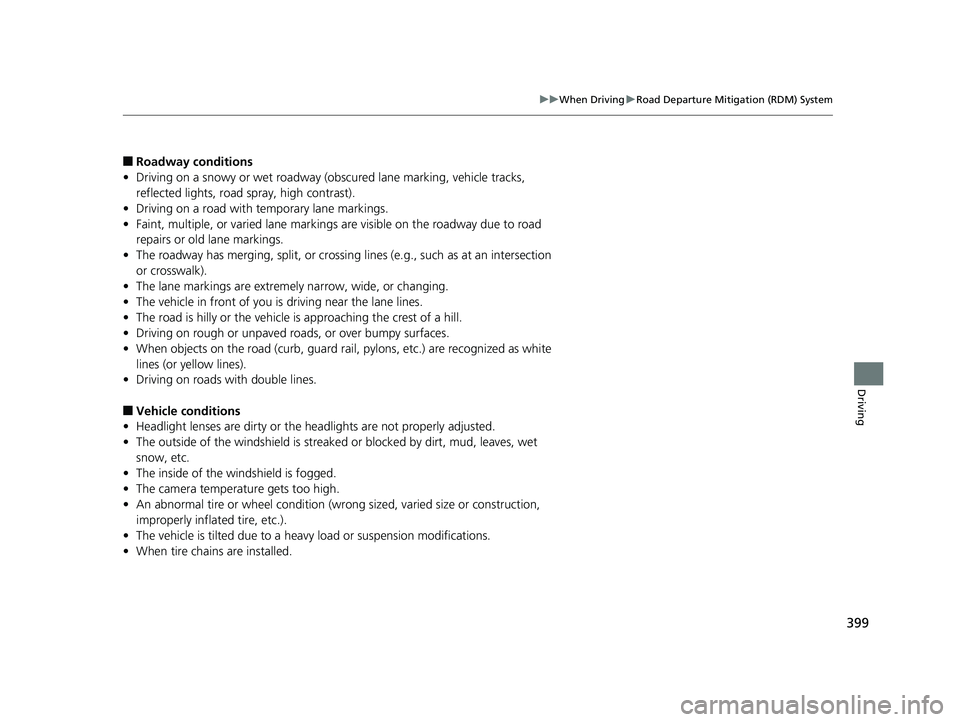
399uu When Driving u Road Departure Mitigation (RDM) System
Driving
■ Roadway conditions
• Driving on a snowy or wet roadway (obs cured lane marking, vehicle tracks,
reflected lights, road spray, high contrast).
• Driving on a road with temporary lane markings.
• Faint, multiple, or varied lane markings are visible on the roadway due to road
repairs or old lane markings.
• The roadway has merging, split, or crossing lines (e.g., such as at an intersection
or crosswalk).
• The lane markings are extremel y narrow, wide, or changing.
• The vehicle in front of you is driving near the lane lines.
• The road is hilly or the vehicle is approaching the crest of a hill.
• Driving on rough or unpaved roads, or over bumpy surfaces.
• When objects on the road (curb, guard rail, pylons, etc.) are recognized as white
lines (or yellow lines).
• Driving on roads with double lines.
■ Vehicle conditions
• Headlight lenses are dirty or the h eadlights are not properly adjusted.
• The outside of the windshield is streaked or blocked by dirt, mud, leaves, wet
snow, etc.
• The inside of the windshield is fogged.
• The camera temperature gets too high.
• An abnormal tire or wheel condition (wro ng sized, varied size or construction,
improperly inflated tire, etc.).
• The vehicle is tilted du e to a heavy load or suspension modifications.
• When tire chains are installed. 18 CLARITY PHEV CSS-31TRW6000.book 399 ページ 2017年8月31日 木曜日 午後2時49分
Page 408 of 591
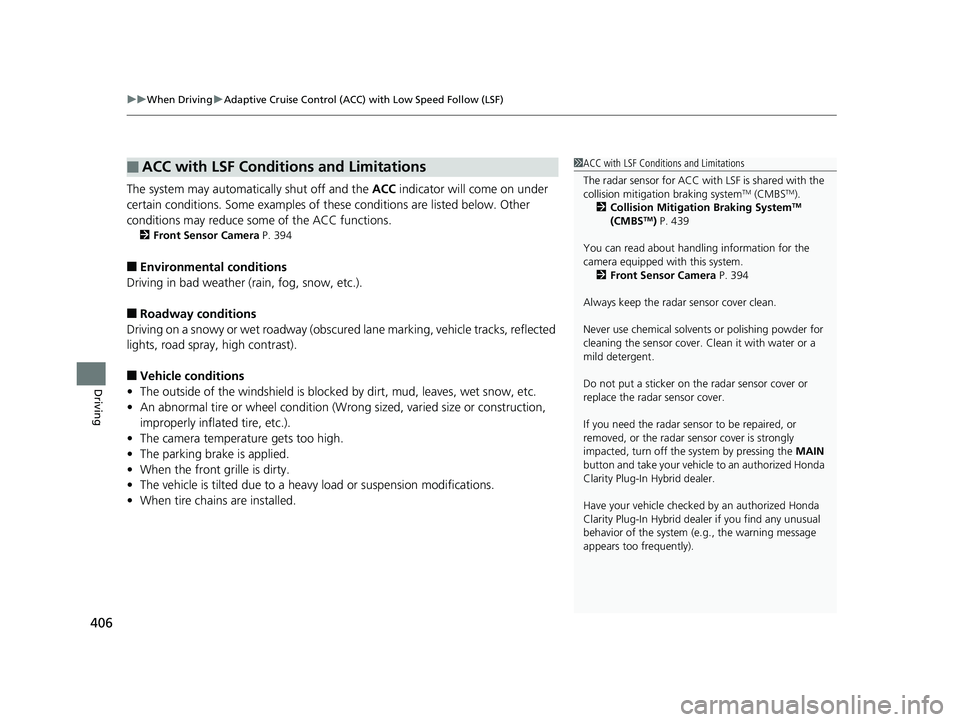
uu When Driving u Adaptive Cruise Control (ACC) with Low Speed Follow (LSF)
406
Driving The system may automatically shut off and the ACC indicator will come on under
certain conditions. Some examples of th ese conditions are listed below. Other
conditions may reduce some of the ACC functions. 2 Front Sensor Camera P. 394
■ Environmental conditions
Driving in bad weather (r ain, fog, snow, etc.).
■ Roadway conditions
Driving on a snowy or wet roadway (obscure d lane marking, vehicle tracks, reflected
lights, road spray, high contrast).
■ Vehicle conditions
• The outside of the windshie ld is blocked by dirt, m ud, leaves, wet snow, etc.
• An abnormal tire or wheel condition (Wrong sized, varied size or construction,
improperly inflated tire, etc.).
• The camera temperature gets too high.
• The parking brake is applied.
• When the front grille is dirty.
• The vehicle is tilted due to a heav y load or suspension modifications.
• When tire chains are installed.■ ACC with LSF Conditions and Limitations 1 ACC with LSF Conditions and Limitations
The radar sensor for ACC with LSF is shared with the
collision mitigation braking system TM
(CMBS TM
).
2 Collision Mitigation Braking System TM
(CMBS TM
) P. 439
You can read about handling information for the
camera equipped with this system.
2 Front Sensor Camera P. 394
Always keep the radar sensor cover clean.
Never use chemical solvents or polishing powder for
cleaning the sensor cover. Clean it with water or a
mild detergent.
Do not put a sticker on the radar sensor cover or
replace the radar sensor cover.
If you need the radar sensor to be repaired, or
removed, or the radar se nsor cover is strongly
impacted, turn off the system by pressing the MAIN
button and take your vehicl e to an authorized Honda
Clarity Plug-In Hybrid dealer.
Have your vehicle checked by an authorized Honda
Clarity Plug-In Hybrid deal er if you find any unusual
behavior of the system (e.g., the warning message
appears too frequently).18 CLARITY PHEV CSS-31TRW6000.book 406 ページ 2017年8月31日 木曜日 午後2時49分
Page 427 of 591
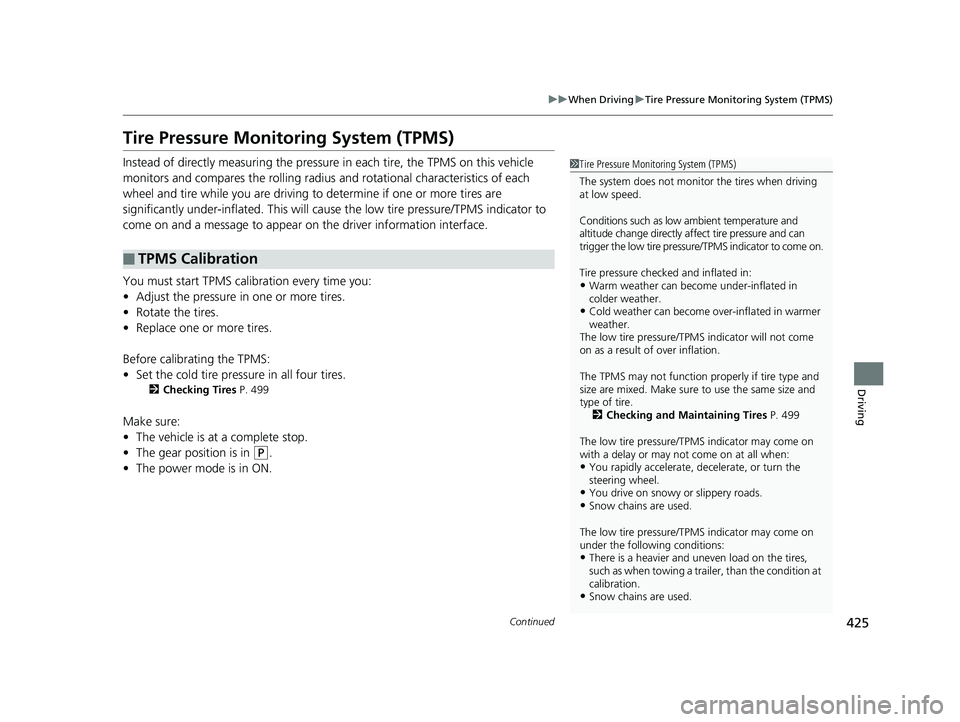
425uu When Driving u Tire Pressure Monitoring System (TPMS)
Continued
Driving
Tire Pressure Monitoring System (TPMS) Instead of directly measuring the pressure in each tire, the TPMS on this vehicle
monitors and compares the rolling radius and rotational characteristics of each
wheel and tire while you are driving to determine if one or more tires are
significantly under-inflated. This will caus e the low tire pressure/TPMS indicator to
come on and a message to appear on the driver information interface.
You must start TPMS calibration every time you:
• Adjust the pressure in one or more tires.
• Rotate the tires.
• Replace one or more tires.
Before calibrating the TPMS:
• Set the cold tire pressure in all four tires. 2 Checking Tires P. 499
Make sure:
• The vehicle is at a complete stop.
• The gear position is in ( P
.
• The power mode is in ON.■ TPMS Calibration 1 Tire Pressure Monitoring System (TPMS)
The system does not monitor the tires when driving
at low speed.
Conditions such as low ambient temperature and
altitude change directly a ffect tire pressure and can
trigger the low tire pressure/TPMS indicator to come on.
Tire pressure checked and inflated in:
• Warm weather can beco me under-inflated in
colder weather.
• Cold weather can become over-inflated in warmer
weather.
The low tire pressure/TPMS indicator will not come
on as a result of over inflation.
The TPMS may not function pr operly if tire type and
size are mixed. Make sure to use the same size and
type of tire.
2 Checking and Maintaining Tires P. 499
The low tire pressure/TPMS indicator may come on
with a delay or may not come on at all when:
• You rapidly accelerate, decelerate, or turn the
steering wheel.
• You drive on snowy or slippery roads.
• Snow chains are used.
The low tire pressure/TPMS indicator may come on
under the following conditions:
• There is a heavier and une ven load on the tires,
such as when towing a trailer, than the condition at
calibration.
• Snow chains are used.18 CLARITY PHEV CSS-31TRW6000.book 425 ページ 2017年8月31日 木曜日 午後2時49分
Page 428 of 591
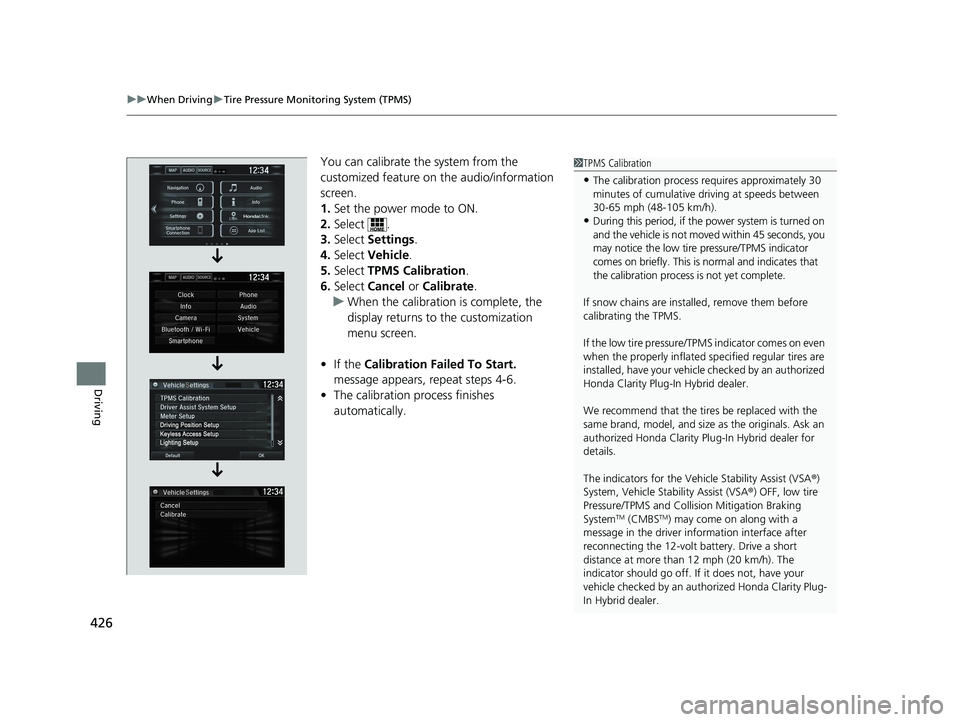
uu When Driving u Tire Pressure Monitoring System (TPMS)
426
Driving You can calibrate the system from the
customized feature on the audio/information
screen.
1. Set the power mode to ON.
2. Select .
3. Select Settings .
4. Select Vehicle .
5. Select TPMS Calibration .
6. Select Cancel or Calibrate .
u When the calibration is complete, the
display returns to the customization
menu screen.
• If the Calibration Failed To Start.
message appears, repeat steps 4-6.
• The calibration pr ocess finishes
automatically. 1 TPMS Calibration
• The calibration process requires appr oximately 30
minutes of cumulative dr iving at speeds between
30-65 mph (48-105 km/h).
• During this period, if the power system is turned on
and the vehicle is not moved within 45 seconds, you
may notice the low tire pressure/TPMS indicator
comes on briefly. This is normal and indicates that
the calibration process is not yet complete.
If snow chains are instal led, remove them before
calibrating the TPMS.
If the low tire pressure/TPMS indicator comes on even
when the properly inflated specified regular tires are
installed, have your vehicl e checked by an authorized
Honda Clarity Plug-In Hybrid dealer.
We recommend that the tires be replaced with the
same brand, model, and size as the originals. Ask an
authorized Honda Clarity Pl ug-In Hybrid dealer for
details.
The indicators for the Vehicle Stability Assist (VSA ® )
System, Vehicle Stability Assist (VSA ® ) OFF, low tire
Pressure/TPMS and Collision Mitigation Braking
System TM
(CMBS TM
) may come on along with a
message in the driver information interface after
reconnecting the 12-volt battery. Drive a short
distance at more than 12 mph (20 km/h). The
indicator should go off. If it does not, have your
vehicle checked by an aut horized Honda Clarity Plug-
In Hybrid dealer.18 CLARITY PHEV CSS-31TRW6000.book 426 ページ 2017年8月31日 木曜日 午後2時49分
Page 439 of 591
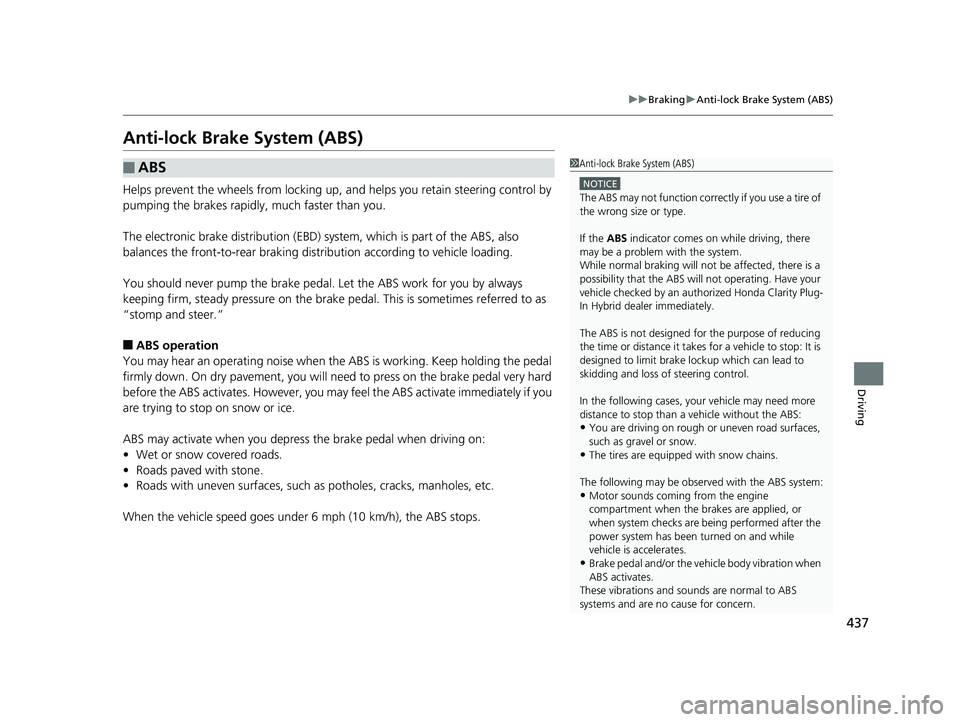
437uu Braking u Anti-lock Brake System (ABS)
Driving
Anti-lock Brake System (ABS) Helps prevent the wheels from locking up, and helps you retain steering control by
pumping the brakes rapidly, much faster than you.
The electronic brake distribu tion (EBD) system, which is part of the ABS, also
balances the front-to-rear braking distribution according to vehicle loading.
You should never pu mp the brake pedal. Let the ABS work for you by always
keeping firm, steady pressure on the brake pe dal. This is sometimes referred to as
“stomp and steer.”
■ ABS operation
You may hear an operating noise when the ABS is working. Keep holding the pedal
firmly down. On dry pavement, you will ne ed to press on the brake pedal very hard
before the ABS activates. Ho wever, you may feel the ABS activate immediately if you
are trying to stop on snow or ice.
ABS may activate when you depres s the brake pedal when driving on:
• Wet or snow covered roads.
• Roads paved with stone.
• Roads with uneven surf aces, such as potholes , cracks, manholes, etc.
When the vehicle speed goes unde r 6 mph (10 km/h), the ABS stops.■ ABS 1 Anti-lock Brake System (ABS) NOTICE
The ABS may not function correc tly if you use a tire of
the wrong size or type.
If the ABS indicator comes on while driving, there
may be a problem with the system.
While normal braking will not be affected, there is a
possibility that the ABS will not operating. Have your
vehicle checked by an aut horized Honda Clarity Plug-
In Hybrid dealer immediately.
The ABS is not designed for the purpose of reducing
the time or distance it takes for a vehicle to stop: It is
designed to limit brake lockup which can lead to
skidding and loss of steering control.
In the following cases, yo ur vehicle may need more
distance to stop than a vehicle without the ABS:
• You are driving on rough or uneven road surfaces,
such as gravel or snow.
• The tires are equipped with snow chains.
The following may be observed with the ABS system:
• Motor sounds coming from the engine
compartment when the brakes are applied, or
when system checks are being performed after the
power system has been turned on and while
vehicle is accelerates.
• Brake pedal and/or the ve hicle body vibration when
ABS activates.
These vibrations and sou nds are normal to ABS
systems and are no cause for concern.18 CLARITY PHEV CSS-31TRW6000.book 437 ページ 2017年8月31日 木曜日 午後2時49分
Page 446 of 591
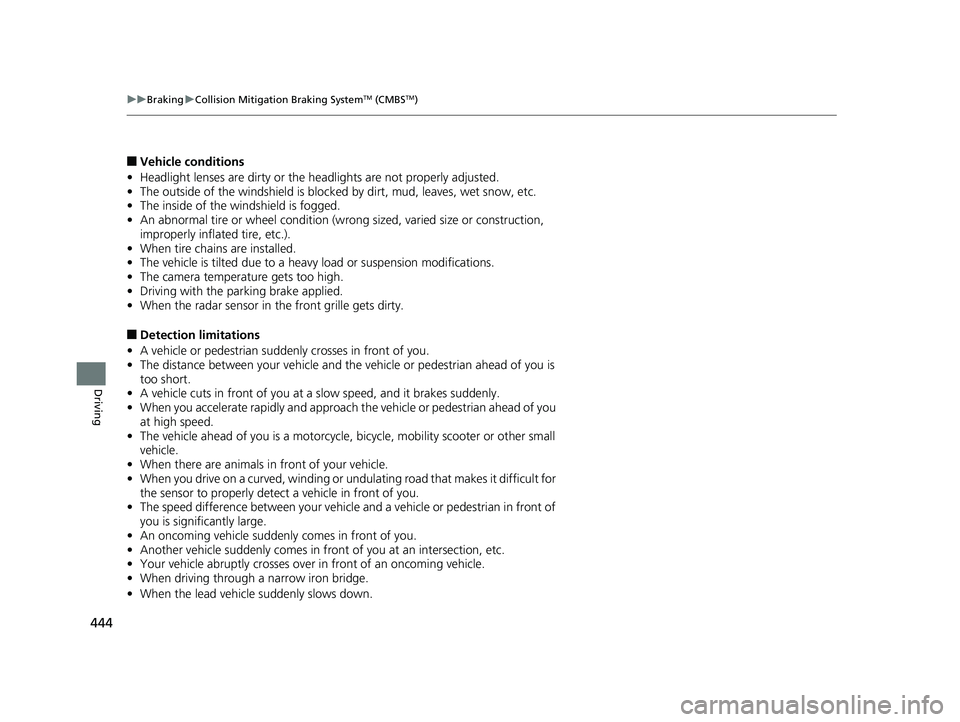
444 uu Braking u Collision Mitigation Braking System TM
(CMBS TM
)
Driving ■ Vehicle conditions
• Headlight lenses are dirty or the headlights are not properly adjusted.
• The outside of the windshie ld is blocked by dirt, m ud, leaves, wet snow, etc.
• The inside of the windshield is fogged.
• An abnormal tire or wheel condition (wrong sized, varied size or construction,
improperly inflated tire, etc.).
• When tire chains are installed.
• The vehicle is tilted due to a heav y load or suspension modifications.
• The camera temperature gets too high.
• Driving with the parking brake applied.
• When the radar sensor in the front grille gets dirty.
■ Detection limitations
• A vehicle or pedestrian suddenly crosses in front of you.
• The distance between your vehicle and the vehicle or pedestrian ahead of you is
too short.
• A vehicle cuts in front of you at a slow speed, and it brakes suddenly.
• When you accelerate rapidly and approach the vehicle or pedestrian ahead of you
at high speed.
• The vehicle ahead of you is a motorcycle, bicycle, mobility scooter or other small
vehicle.
• When there are animals in front of your vehicle.
• When you drive on a cu rved, winding or undu lating road that makes it difficult for
the sensor to properly detect a vehicle in front of you.
• The speed difference between your vehicle an d a vehicle or pedestrian in front of
you is significantly large.
• An oncoming vehicle suddenly comes in front of you.
• Another vehicle suddenly comes in front of you at an intersection, etc.
• Your vehicle abruptly crosses over in front of an oncoming vehicle.
• When driving through a narrow iron bridge.
• When the lead vehicle suddenly slows down. 18 CLARITY PHEV CSS-31TRW6000.book 444 ページ 2017年8月31日 木曜日 午後2時49分
Page 509 of 591
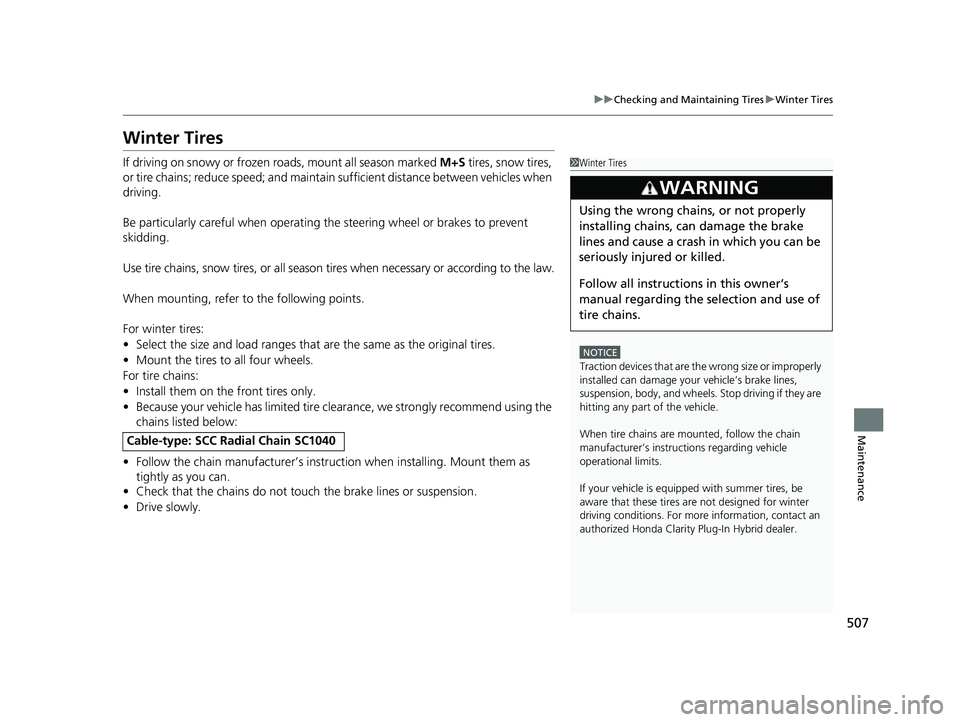
507uu Checking and Maintaining Tires u Winter Tires
Maintenance
Winter Tires If driving on snowy or frozen roads, mount all season marked M+S tires, snow tires,
or tire chains; reduce speed; and maintain sufficient distance be tween vehicles when
driving.
Be particularly careful wh en operating the steering wheel or brakes to prevent
skidding.
Use tire chains, snow tires, or all season ti res when necessary or according to the law.
When mounting, refer to the following points.
For winter tires:
• Select the size and load ranges that are the same as the original tires.
• Mount the tires to all four wheels.
For tire chains:
• Install them on the front tires only.
• Because your vehicle has limited tire clea rance, we strongly recommend using the
chains listed below:
• Follow the chain manufactur er’s instruction when in stalling. Mount them as
tightly as you can.
• Check that the chains do not touc h the brake lines or suspension.
• Drive slowly.Cable-type: SCC Radial Chain SC1040 1 Winter Tires
NOTICE
Traction devices that are th e wrong size or improperly
installed can damage your vehicle’s brake lines,
suspension, body, and wheels. Stop driving if they are
hitting any part of the vehicle.
When tire chains are mounted, follow the chain
manufacturer’s instructi ons regarding vehicle
operational limits.
If your vehicle is equipp ed with summer tires, be
aware that these tires are not designed for winter
driving conditions. For more information, contact an
authorized Honda Clarity Plug-In Hybrid dealer.3
WARNING Using the wrong chains, or not properly
installing chains, can damage the brake
lines and cause a crash in which you can be
seriously injured or killed.
Follow all instruction s in this owner’s
manual regarding the selection and use of
tire chains.18 CLARITY PHEV CSS-31TRW6000.book 507 ページ 2017年8月31日 木曜日 午後2時49分
Page 589 of 591
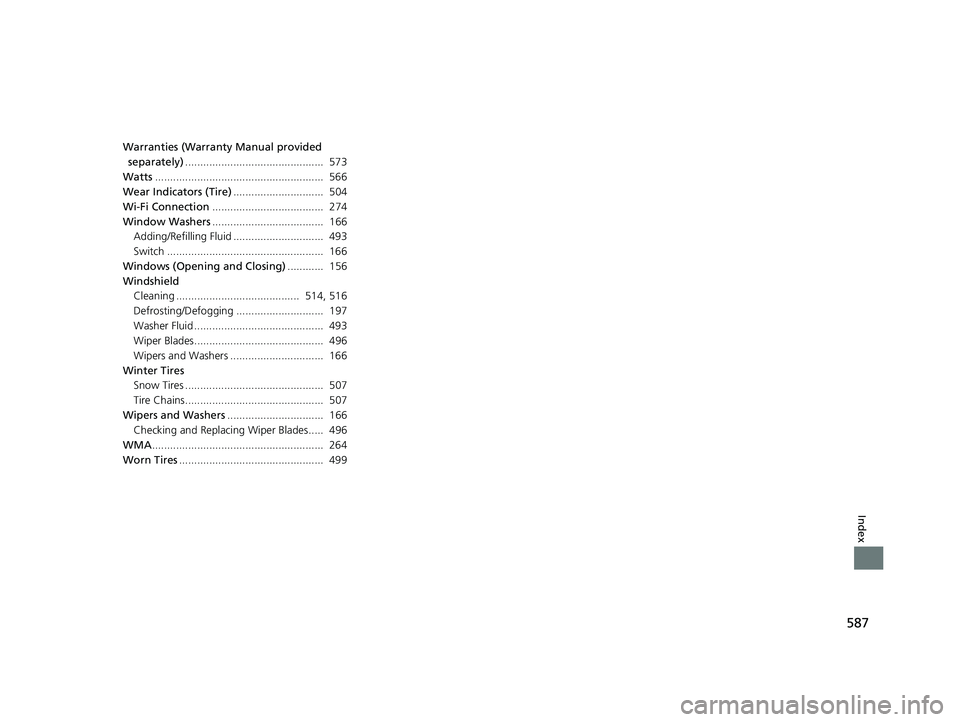
587
Index
Warranties (Warranty Manual provided
separately) .............................................. 573
Watts ........................................................ 566
Wear Indicators (Tire) .............................. 504
Wi-Fi Connection ..................................... 274
Window Washers ..................................... 166
Adding/Refilling Fluid .............................. 493
Switch .................................................... 166
Windows (Opening and Closing) ............ 156
Windshield
Cleaning ......................................... 514, 516
Defrosting/Defogging ............................. 197
Washer Fluid ........................................... 493
Wiper Blades........................................... 496
Wipers and Washers ............................... 166
Winter Tires
Snow Tires .............................................. 507
Tire Chains.............................................. 507
Wipers and Washers ................................ 166
Checking and Replacing Wiper Blades..... 496
WMA ......................................................... 264
Worn Tires ................................................ 49918 CLARITY PHEV CSS-31TRW6000.book 587 ページ 2017年8月31日 木曜日 午後2時49分